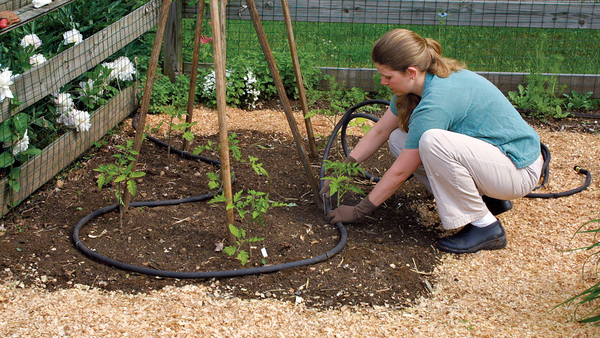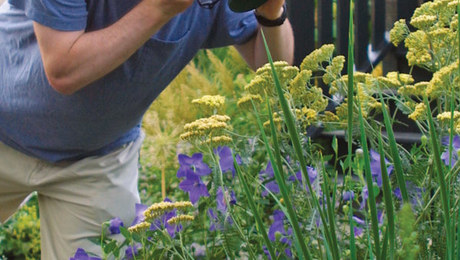
You’ve probably heard people singing the praises of drip irrigation, which was developed in the early 60s in Israel. I thought it was the greatest thing since sliced bread when it arrived on the scene during SoCal’s big drought in the late 70s. The idea is simple: water trickles out of a piece of tubing right next to the plant and soaks right into the root zone. No misting or overspray and minimal evaporation.
Simple or not, I haven’t been a big fan of this serpentine system for one reason–drip doesn’t keep up with the expanding root system.
Expandability: When plants get bigger, their root systems have to get bigger. But most people put a young one-gallon size plant in the ground, drop one emitter right above the root ball and assume that’s all they’ll ever need to do. Not so fast, buster.
If YOU were a Ceanothus griseus horizontalis ‘Yankee Point’ dreaming of growing ten feet across, you need a root system robust enough to support all the biomass above ground. So why would you send your roots out into dry soil when it’s nice and moist under that original drip emitter? I’d just hang back where the soil is cool and moist.
You’ve heard the phrase, “You can lead a horse to water…”? Same for the roots. If you don’t expand the drip system outward in concentrically wider circles, you can’t lead roots out where they need to be. The result? Stunted growth.
In-Line Technology The innovation that corrects this problem is called “in-line drip tubing”, manufactured by Netafim, Toro and a few other companies. The emitters are molded inside the tubing so all you see from the outside are predrilled, evenly spaced holes, usually at 12″ or 18″ apart.
The innovation that corrects this problem is called “in-line drip tubing”, manufactured by Netafim, Toro and a few other companies. The emitters are molded inside the tubing so all you see from the outside are predrilled, evenly spaced holes, usually at 12″ or 18″ apart.
The best use of in-line drip tubing for home gardens is a grid layout. Let’s say you want to plant a big area of your garden with a mix of shrubs, perennials and herbaceous ground covers arranged naturalistically in curves and drifts. Now imagine the pasta puzzle you’d create with traditional drip systems. Black tubes snaking and writhing hither and yon. Medusa comes to mind.
The magic of in-line is that the entire area within the grid gets evenly moist, allowing you to plant wherever you want. Just make sure all your plants are selected to thrive with about the same amount of water.
Easy Peasy Set-up
We’re going to make a simple grid. Follow along with the graphic.
 1) Outline the entire bed with a single strand of in-line tubing, creating a closed loop with one tee fitting leading back to the water valve, kind of like a lariat.
1) Outline the entire bed with a single strand of in-line tubing, creating a closed loop with one tee fitting leading back to the water valve, kind of like a lariat.
2) Run parallel rows within the outlined area. If the predrilled holes in the tubing are 18 inches apart, your tubing grid will be evenly spaced at 18 inches. It ends up looking like a sheet of notebook paper with neatly drawn lines within.
3) Offset the pre-drilled tubing so that the in-line emitter locations create a triangular pattern.
The magic of this system is that you end up with water evenly distributed everywhere. This allows you to plant whatever you want wherever you want without having to snake tubing all over the place.
One more thing. Although most in-line tubing can be installed below ground, I suggest leaving on top of the soil and covering it will a 3″ deep layer of wood chips. That prevents ultraviolet rays from harming the pipe, hides the industrial look and gives you all the soil-building benefits of organic mulch.
As much as I enjoy imparting useful information about water conservation and sustainability, my inner Dave Barry is clawing to get out. Next up, what happens when Microsoft decides to “interface” with your veggie plot?

















Comments
There is a porous soaker hose which has been around for awhile and works on the same principle. This sounds better: with our mineral-y water, the soaker hose gets pretty clogged after a season. I'd be curious to see how big these micro-holes are, and how long the tubing lasts, even buried. Didn't know the Israelis started drip irrigation; a lot of our smart horticultural ideas (and plants) come from there.
Pomona,
The heavier tubing is substantially more costly than the thin drip tapes (like 30 cents/foot vs. 4 cents/foot), but even the cheap stuff lasts several years without clogging. Water actually flows instead of seeping, they tend to clean themselves out, and the minerals don't stick to the poly material very well.
When you consider the amount of water loss through evaporation during spraying and the number of disease spores spread by flying water, area drip systems like this make a lot of sense.
Ive never done irrigation. I have been planning to try it. I usually hand water my entire garden, sometimes overwatering. Hand watering does take alot of time. We are about to Re-Landscape the backyard in a few weeks with raised garden beds and rock landscaping.Your article gives me some good ideas and where to start! If you have any other tips for me, I would love to hear them. Im in Antelope area near Sacramento. Thanks!
We have done Techline on a grid in one of the gardens we maintain for over eight years, gradually converting mixed planting beds from the antiquated spray system installed back in the 70's. It is true that self-cleaning, pressure-regulated in-line emmiter tubing is more expensive than conventional drip or spray. However, the benefits and longevity of a properly installed grid will save countless hours and significant amounts of water over the long haul.
Because moisture is uniformly distributed, there is no "irrigation bondage" of the root system, i.e., roots growing only where there is available water from an emitter. This is significant and eliminates one of the big downsides of drip vs. spray. The grid is in a predictable configuration, so change-out or augmentation of plantings is easy and doesn't result in sliced-up spaghetti tubing, a constant maintenance nightmare, particularly in gardens where less-than-stellar maintenance has preceded our involvement in a garden.
Over time, we've observed a few keys to success, one of them being a requirement to hand water *new* plantings for a couple of weeks to get healthy root balls established. We also regularly replenish the mulch both for aesthetic reasons, and to protect the tubing from solar degradation. Repeated short cycles allow percolation of moisture through the soil with no runoff in clay. This doesn't mean shallow watering, but gradual application of water for on less frequent watering days. This encourages deeper rooting and greater drought resistance.
This system is sometimes a hard sell to homeowners and installing contractors, but we've now successfully deployed "the grid" in at least half of the gardens we maintain and it is almost exclusively my choice for mixed beds of perennials, shrubs, and trees when I design and install new gardens.
We have done Techline on a grid in one of the gardens we maintain for over eight years, gradually converting mixed planting beds from the antiquated spray system installed back in the 70's. It is true that self-cleaning, pressure-regulated in-line emmiter tubing is more expensive than conventional drip or spray. However, the benefits and longevity of a properly installed grid will save countless hours and significant amounts of water over the long haul.
Because moisture is uniformly distributed, there is no "irrigation bondage" of the root system, i.e., roots growing only where there is available water from an emitter. This is significant and eliminates one of the big downsides of drip vs. spray. The grid is in a predictable configuration, so change-out or augmentation of plantings is easy and doesn't result in sliced-up spaghetti tubing, a constant maintenance nightmare, particularly in gardens where less-than-stellar maintenance has preceded our involvement in a garden.
Over time, we've observed a few keys to success, one of them being a requirement to hand water *new* plantings for a couple of weeks to get healthy root balls established. We also regularly replenish the mulch both for aesthetic reasons, and to protect the tubing from solar degradation. Repeated short cycles allow percolation of moisture through the soil with no runoff in clay. This doesn't mean shallow watering, but gradual application of water for on less frequent watering days. This encourages deeper rooting and greater drought resistance.
This system is sometimes a hard sell to homeowners and installing contractors, but we've now successfully deployed "the grid" in at least half of the gardens we maintain and it is almost exclusively my choice for mixed beds of perennials, shrubs, and trees when I design and install new gardens.
Plantanista, PomonaB and Mike: Thanks for the ringing endorsement of Techline and the in-line approach to drip tubing. It's always nice to have this kind of tech information validated from folks working right on the front line.
This is great information, definitely putting it to use soon. My uncle is bought a lot of Netafim after a trip to Israel. Only we set it up like traditional black drip with one emitter at each plant on a steep hill with a very low survival rate, we are going to reuse it in a grid method on the new terraces below. Thanks.
Any chance you'll talk about Olla irrigation in a future post?
- Jacky
Jacky: you caught me. I'm ignorant of Olla irrigation. Now I've got some research to do. Any resources you can send my way would be great. You have my direct e-mail from our permaculture class. BTW: thanks for tracking me down and staying in touch. Mucho appreciation.
Log in or create an account to post a comment.
Sign up Log in